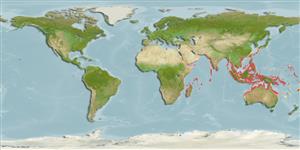Environment: milieu / climate zone / depth range / distribution range
Ecologie
marien demersaal; diepte ? - 17 m (Ref. 11441). Tropical
Indo-West Pacific: India and Sri Lanka to western Thailand, Sumatra and the southern islands of Indonesia, and northwestern Australia.
Grootte / Gewicht / Leeftijd
Maturity: Lm ? range ? - ? cm
Max length : 15.0 cm SL mannelijk / geslacht onbekend; (Ref. 9774); common length : 10.0 cm SL mannelijk / geslacht onbekend; (Ref. 9774)
Dorsale stekels (totaal): 0; Dorsale zachte stralen (totaal): 65-70; Anale stekels 0; Anale zachte stralen: 49 - 52. Body brownish, with 1 ocellus above and below lateral line and 1 ocellus on posterior third of straight section of lateral line. Many indistinct spots and blotches on body. Pectoral fin on ocular side with 11-12 soft rays (Ref 9774).
Found on the muddy and sandy bottoms of the continental shelf. Feeds on benthic organisms. Sold fresh and dried salted in markets.
Levenscyclus en paargedrag
Maturiteit | Voortplanting | Paaien | Eieren | Fecunditeit | Larven
Distinct pairing (Ref. 205).
Nielsen, J.G., 1984. Bothidae. In W. Fischer and G. Bianchi (eds.) FAO species identification sheets for fishery purposes. Western Indian Ocean fishing area 51. Vol. 1. FAO, Rome. pag. var. (Ref. 3322)
Status op de Rode Lijst van het IUCN (Ref. 130435)
Gevaar voor de mens
Harmless
Gebruik door de mens
Visserij: commercieel; Aquarium: Publieke aquaria
Meer informatie
Leeftijd/GrootteGroeiLengte-gewichtLengte-lengteLengtefrequentiesMorfometrieMorfologieLarvenLarvale populatiedynamiekRekruteringAbundantieBRUVS
ReferentiesAquacultuurAquacultuurprofielKweeklijnenGeneticaElectrophoresesErfelijkheidZiektesVerwerkingNutrientsMassaconversie
Tools
Speciale rapporten
Download XML
Internetbronnen
Estimates based on models
Preferred temperature (Ref.
123201): 25.2 - 29.2, mean 28.5 °C (based on 2471 cells).
Fylogenetische diversiteitsindex (Ref.
82804): PD
50 = 0.5000 [Uniqueness, from 0.5 = low to 2.0 = high].
Bayesian length-weight: a=0.00741 (0.00343 - 0.01604), b=3.17 (3.00 - 3.34), in cm total length, based on LWR estimates for this Genus-body shape (Ref.
93245).
Trofisch niveau (Ref.
69278): 3.5 ±0.37 se; based on food items.
Weerstandsvermogen (Ref.
120179): Hoog, minimale populatieverdubbelingstijd minder dan 15 maanden (Preliminary K or Fecundity.).
Fishing Vulnerability (Ref.
59153): Low vulnerability (10 of 100).
